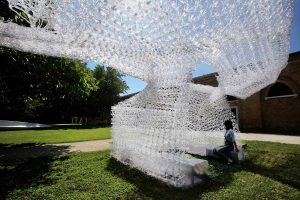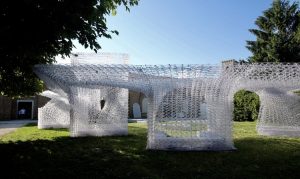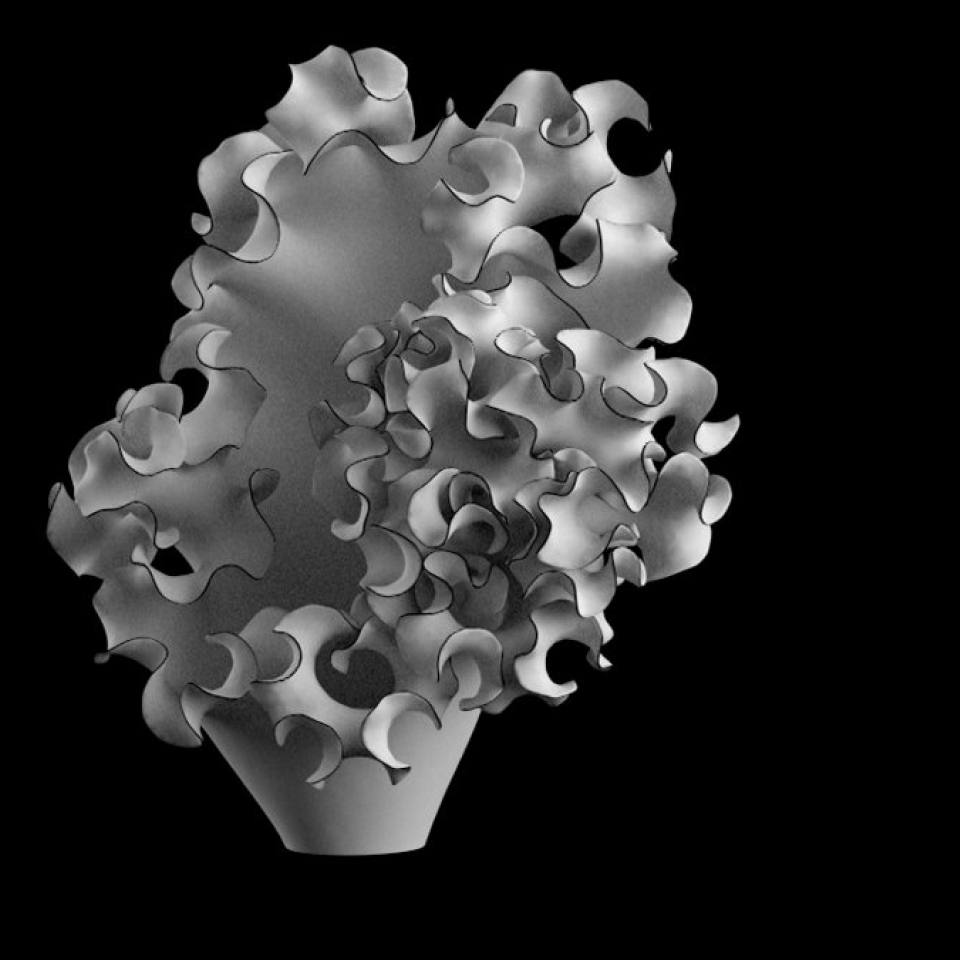function setup() {
createCanvas(640,480);
}
function draw() {
background(245,189,65);
noStroke();
fill(255);
//arms
var bodyWidth=280;
var leftArmCenterX=mouseX;
var leftArmCenterY=mouseY;
leftArmCenterX=constrain(leftArmCenterX,20,160);
var rightArmCenterX=mouseX;
var rightArmCenterY=mouseY;
rightArmCenterX=constrain(rightArmCenterX,480,620);
//left arm
push();
translate(leftArmCenterX,leftArmCenterY);
rotate(radians(135));
fill(255);
ellipse(0,0,80,80);
pop();
//right arm
push();
translate(rightArmCenterX,rightArmCenterY);
rotate(radians(225));
ellipse(0,0,80,80);
pop();
strokeWeight(60);
stroke(255);
line(leftArmCenterX,leftArmCenterY,width/2-(bodyWidth*0.35),280);
line(rightArmCenterX,rightArmCenterY,width/2+(bodyWidth*0.35),280);
//body
noStroke();
arc(width/2,420,bodyWidth,540,PI,2*PI);
arc(width/2,420,bodyWidth,80,0,PI);
//collar
var collarWidth=bodyWidth*0.7;
fill(255,0,0);
ellipse(width/2,220,collarWidth,100);
fill(245,189,65);
ellipse(width/2,270,40,40);
//ears
strokeWeight(1);
fill(255);
//left ear
var earChangeY=mouseY/48;
var earHeight=20+(earChangeY*1.5);
var earChangeX=mouseX/64;
var earLPos=(width/2)-110-(earChangeX*3);
triangle(earLPos,earHeight,380,100,200,150);
fill(255,0,0);
triangle(earLPos+10,earHeight+15,370,100,210,150);
//right ear
fill(255);
var earRPos=(width/2)+110+(earChangeX*3);
triangle(earRPos,earHeight,260,100,440,150);
fill(255,0,0);
triangle(earRPos-10,earHeight+15,260,100,430,150);
//head
fill(255);
ellipse(width/2,140,240,200);
//face
fill(0);
//mouth
fill(255);
stroke(0);
strokeWeight(3);
var mouthMoveX=mouseX/64;
var mouthMoveY=mouseY/32;
var endMouthLeft=0.7*PI+(mouthMoveX/PI);
var endMouthRight=2.3*PI-(mouthMoveY/PI);
endMouthLeft=constrain(endMouthLeft,0.5*PI,1.2*PI);
endMouthRight=constrain(endMouthRight,1.8*PI,2.5*PI);
arc(width/2-15,170,30,30,0,endMouthLeft);
arc(width/2+15,170,30,30,endMouthRight,PI);
//nose
fill(0);
triangle(width/2,170,width/2-15,150,width/2+15,150);
//eyes
var strokeD=((mouseX/64)+(mouseY/48)/2);
strokeD=constrain(strokeD,3,5);
var eyeD=strokeWeight(strokeD);
//left eye
noFill();
arc((width/2)-50,130,40,30,PI*1.1,2*PI);
//right eye
arc((width/2)+50,130,40,30,PI,1.9*PI);
//whiskers
var whiskerMoveX=mouseX/64;
var whiskerMoveY=mouseY/32;
var whiskerLeftX=width-width/1.7+whiskerMoveX-20;
var whiskerY=135+whiskerMoveY;
var whiskerRightX=width-whiskerLeftX;
stroke(0);
strokeWeight(3);
line(whiskerLeftX,whiskerY,280,145);
line(whiskerLeftX,whiskerY+30,280,165);
line(360,145,whiskerRightX,whiskerY);
line(360,165,whiskerRightX,whiskerY+30);
//feet
fill(255);
var footPos=430;
stroke(0);
arc(width/2.7,footPos,70,90,1.05*PI,2.05*PI);
arc(width-(width/2.7),footPos,70,90,0.95*PI,1.95*PI);
}Through the project, I understood better setting the variables as well as the motion using push and pop function. I found changing the position and size of objects using mouseX and mouseY is interesting highly applicable.
![[OLD FALL 2018] 15-104 • Introduction to Computing for Creative Practice](../../../../wp-content/uploads/2020/08/stop-banner.png)


